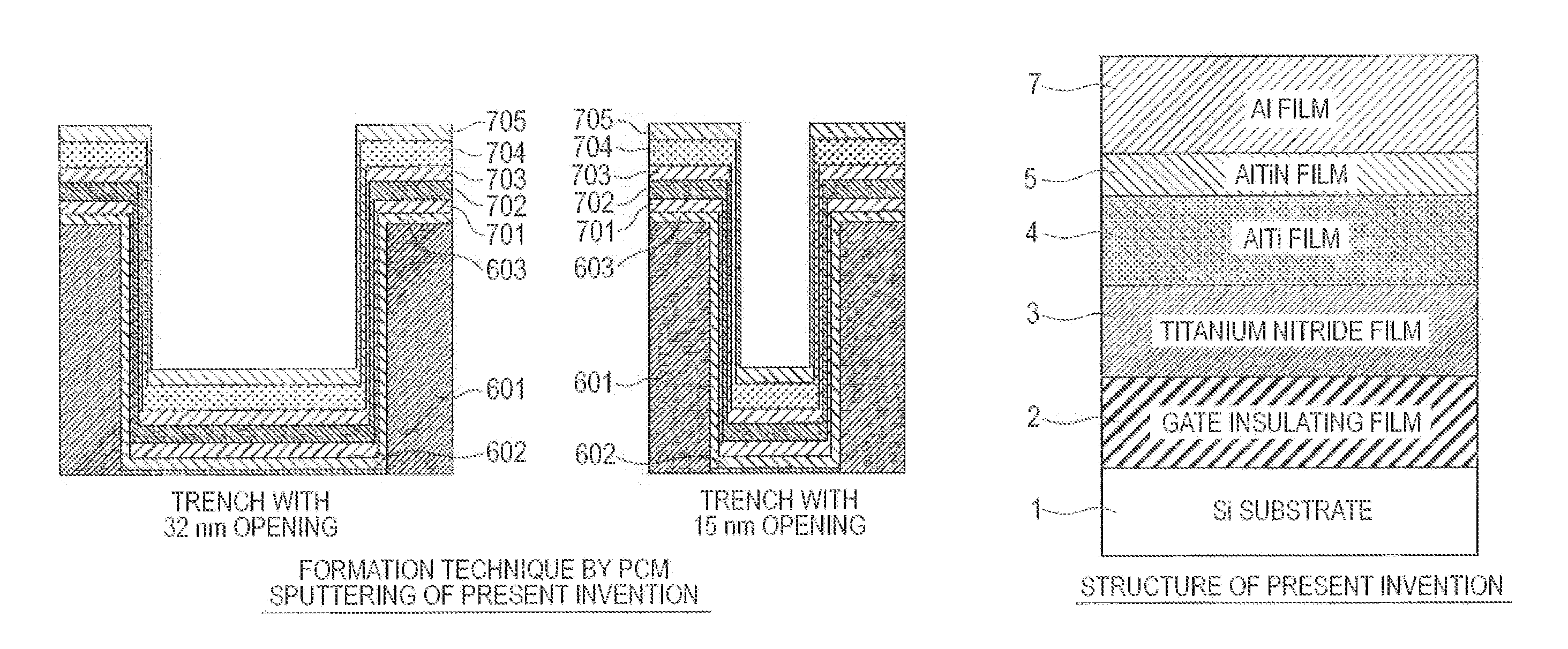Electronic component manufacturing method and electrode structure
a manufacturing method and electrode technology, applied in the direction of vacuum evaporation coating, coating, electric discharge tubes, etc., can solve the problems of narrow trench opening, narrow trench opening, and need for thick deposited ti and tin laminated barrier film, so as to reduce the opening diameter and improve the yield of gate-last devices , the effect of reducing the diameter of the opening
- Summary
- Abstract
- Description
- Claims
- Application Information
AI Technical Summary
Benefits of technology
Problems solved by technology
Method used
Image
Examples
embodiment
[0049]As a result of intensive studies to solve the above problem, the present inventors have completed the present invention by finding out that a second electrode constituting layer (e.g., an Al wiring layer) can be directly embedded smoothly without unevenness on an ultrathin barrier layer (e.g., a TiAlN film) even when there is no Seed-Al layer further formed between the ultrathin barrier layer (e.g., the TiAlN film) and the second electrode constituting layer (e.g., the Al wiring layer) by forming a first electrode constituting layer (e.g., a TiAl film) in a recess (e.g., a trench) formed in a workpiece (a first step), forming the ultrathin barrier layer (e.g., the TiAlN film) by plasma nitriding the surface of the first electrode constituting layer (e.g., the TiAl film) to form a nitrided layer (a second step), and then forming the second electrode constituting layer (e.g., the Al wiring layer) on the ultrathin barrier layer (e.g., the TiAlN film) (a third step). More specific...
first example
[0090]A first example of the present invention is described in detail with reference to the drawings. FIGS. 15D and 15E are diagrams showing a first step of forming a TiAl film in a trench structure using the PCM sputtering apparatus 100 of the present invention shown in FIGS. 1 and 6, a second step of forming a TiAlN layer on a TiAl surface layer by plasma nitridation, and then a third step of Al embedding. First, as shown in FIG. 15D, a TiAl film 905 is deposited in trench structures 901 and 902 by sputtering. A metal alloy target of TiAl is used as a target, and Ar is used as sputtering gas. Next, the TiAl film 905 is plasma-nitrided using a Ti metal target and nitrogen gas as a gas to form a nitrogen plasma, thus converting the TiAl film 905 into a TiAlN film 905. Note that although the whole TiAl film 905 is converted into the TiAlN film 905 by plasma nitridation in this example, only a part (e.g., a surface) of the TiAl film 905 may be converted. Next, as shown in FIG. 15E, an...
second example
[0093]A second example is one applied to the gate-last method.
[0094]The second example of the present invention is described below with reference to the drawings. FIGS. 15A to 15F are diagrams showing steps of a method for manufacturing a semiconductor device as the second example of the present invention. In this example, in a region to form an N-type MOSFFT as a first region and a region to form a P-type MOSFET as a second region, metal gate electrodes that realize suitable effective work functions are formed by performing the first step of depositing a TiAl film, the second step of forming a TiAlN barrier layer by plasma nitridation and the third step of Al embedding in the first example.
[0095]As shown in FIG. 15A, trench structures 901 and 902 are formed in the region to form the N-type MOSFFT and the region to form the P-type MOSFFT. Next, as shown in FIG. 15B, a metal nitride film B903 and a metal nitride film C904 are formed using the sputtering apparatus of the present inven...
PUM
| Property | Measurement | Unit |
|---|---|---|
| opening diameter | aaaaa | aaaaa |
| temperature | aaaaa | aaaaa |
| thickness | aaaaa | aaaaa |
Abstract
Description
Claims
Application Information
 Login to View More
Login to View More - Generate Ideas
- Intellectual Property
- Life Sciences
- Materials
- Tech Scout
- Unparalleled Data Quality
- Higher Quality Content
- 60% Fewer Hallucinations
Browse by: Latest US Patents, China's latest patents, Technical Efficacy Thesaurus, Application Domain, Technology Topic, Popular Technical Reports.
© 2025 PatSnap. All rights reserved.Legal|Privacy policy|Modern Slavery Act Transparency Statement|Sitemap|About US| Contact US: help@patsnap.com



